Abstract
1. The aim of this study is to address the problem of the controlled variable in quadrupedal stance. In particular, we considered whether the projection of the centre of mass of the body on the support surface or the joint torques or the geometrical configuration of the limbs are primarily controlled. 2. Cats were trained to stand freely on a platform which could be tilted in the sagittal plane by up to +/- 20 deg. The normal and tangential components of the contact forces at each paw were measured by means of load cells. The position of limb joints was recorded by means of the ELITE system. 3. The projection of the centre of body mass on the platform, as well as the orientation and length of limb axes, varied to only a limited extent with tilt angle. In particular, the limb axes were closely lined up with the vertical, as were the vectors of the contact forces at the paws. As a result, the torques at the proximal joints (scapula and hip) were close to zero and the torques at the other joints varied little with table tilt. 4. In order to test the different hypotheses on postural control, an external load (10-20% of the animal weight) was applied to the cat forequarters. The projected centre of mass consistently shifted forwards, contrary to the hypothesis that this parameter is controlled in stance. Instead, the geometry of limb posture remained unmodified after load application, even though the torques at forelimb joints were much greater than in the control. 5. This postural behaviour showed no sign of adaptation over a period of 24 h of continuous load application. 6. It is concluded that limb geometry is primarily controlled in stance. The results are discussed in the context of current notions on hierarchical control and body scheme.
Full text
PDF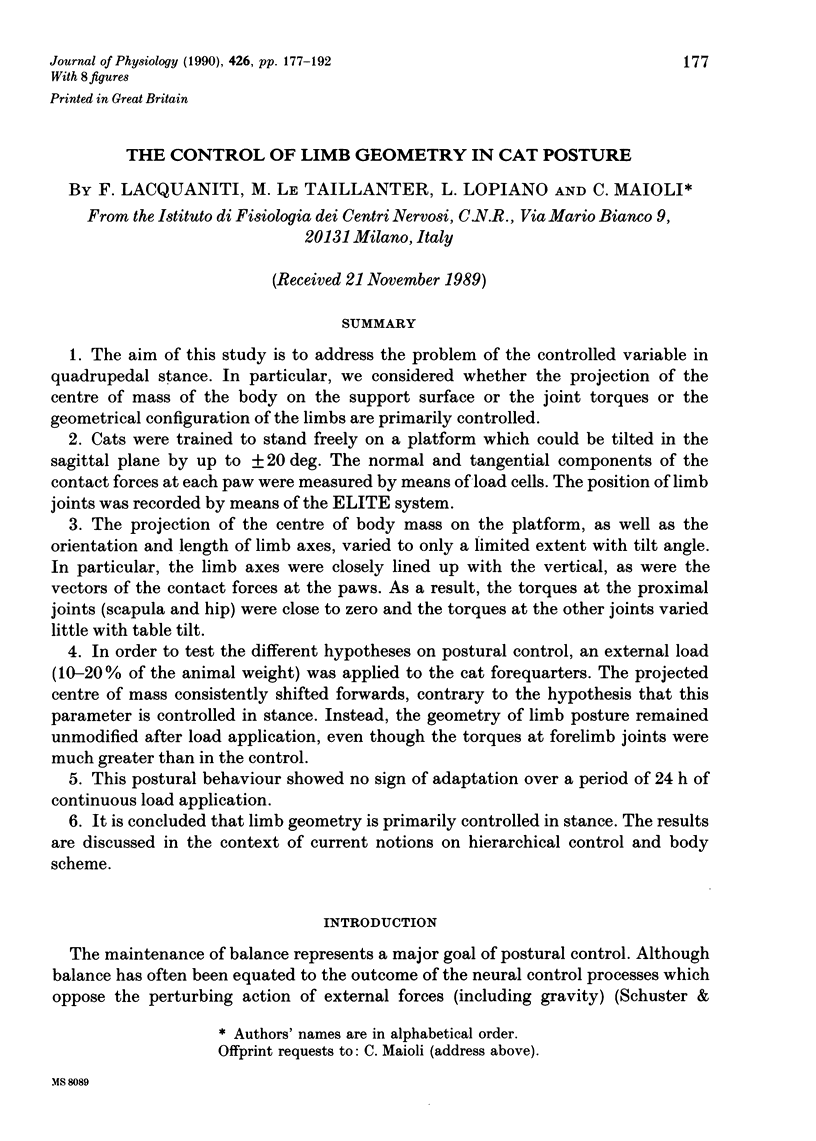
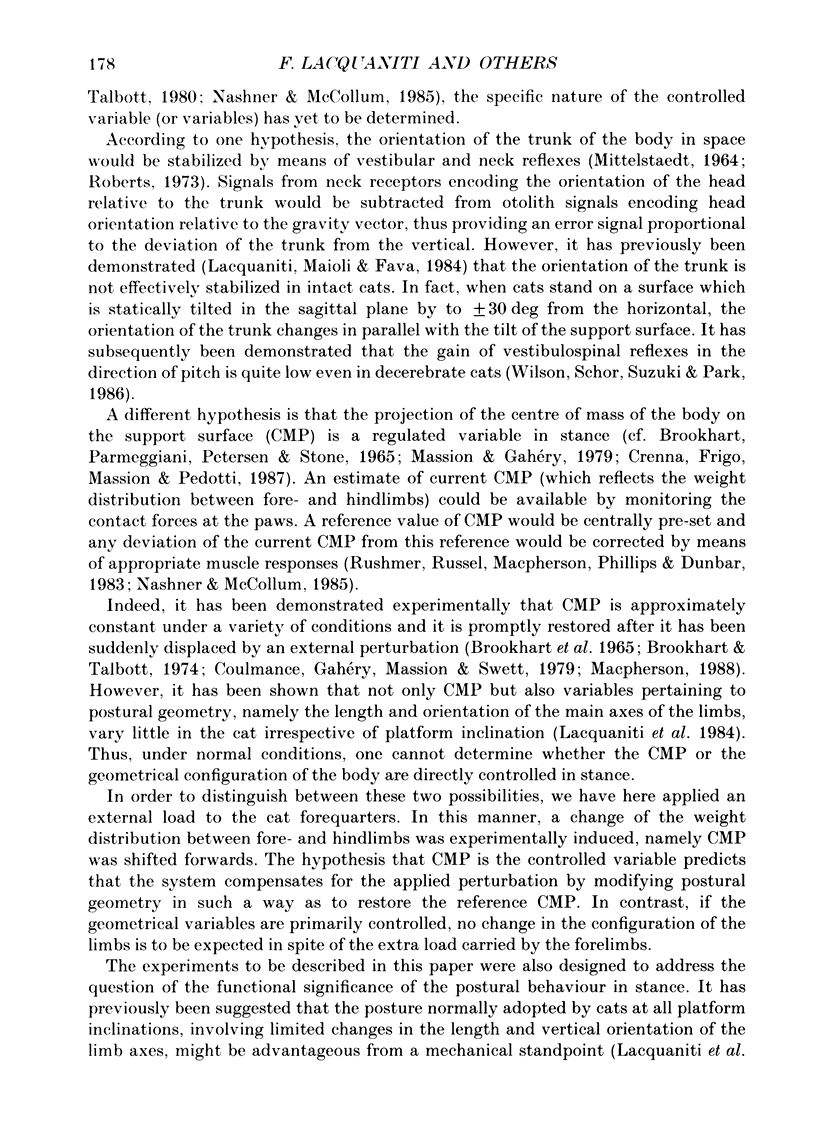
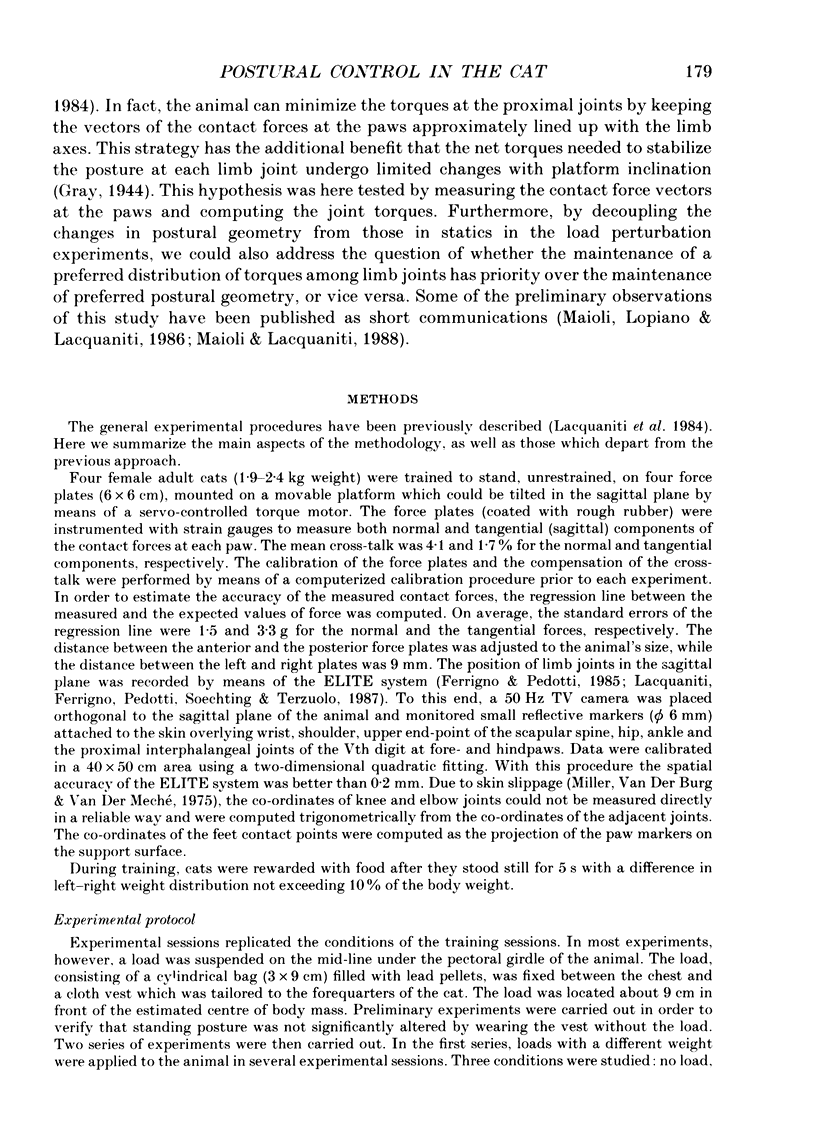
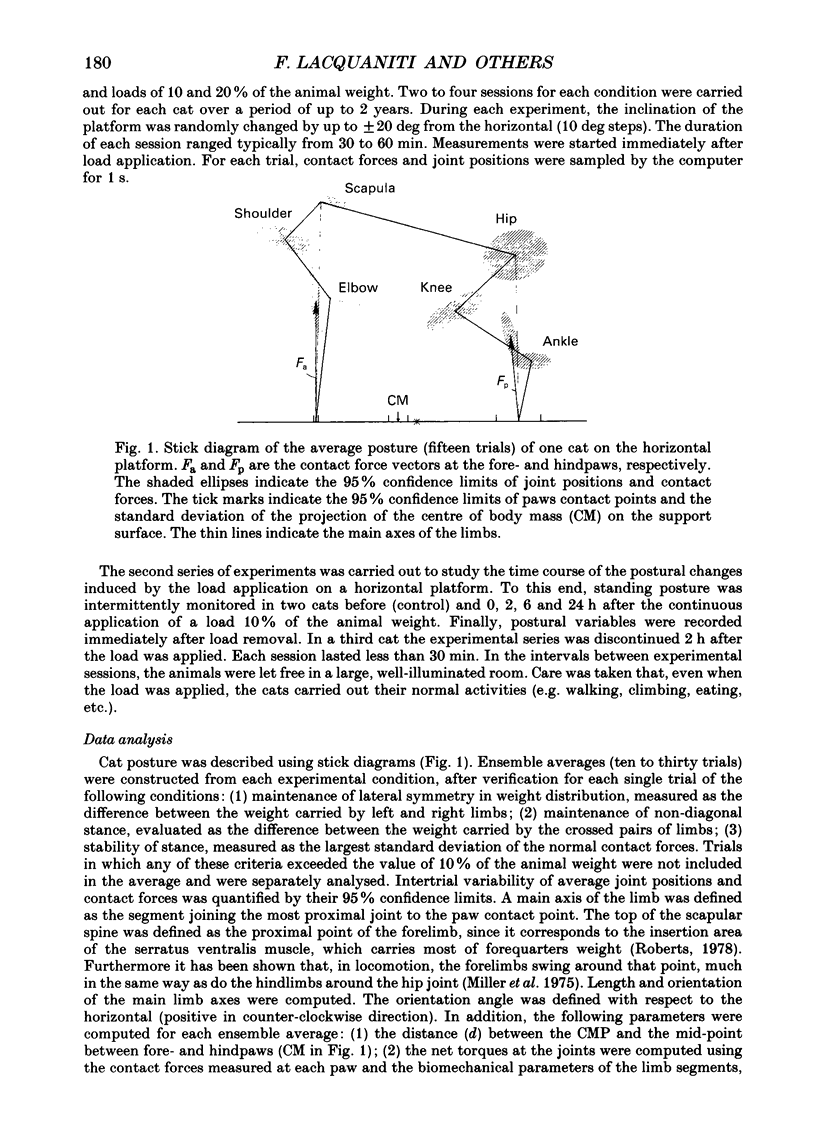
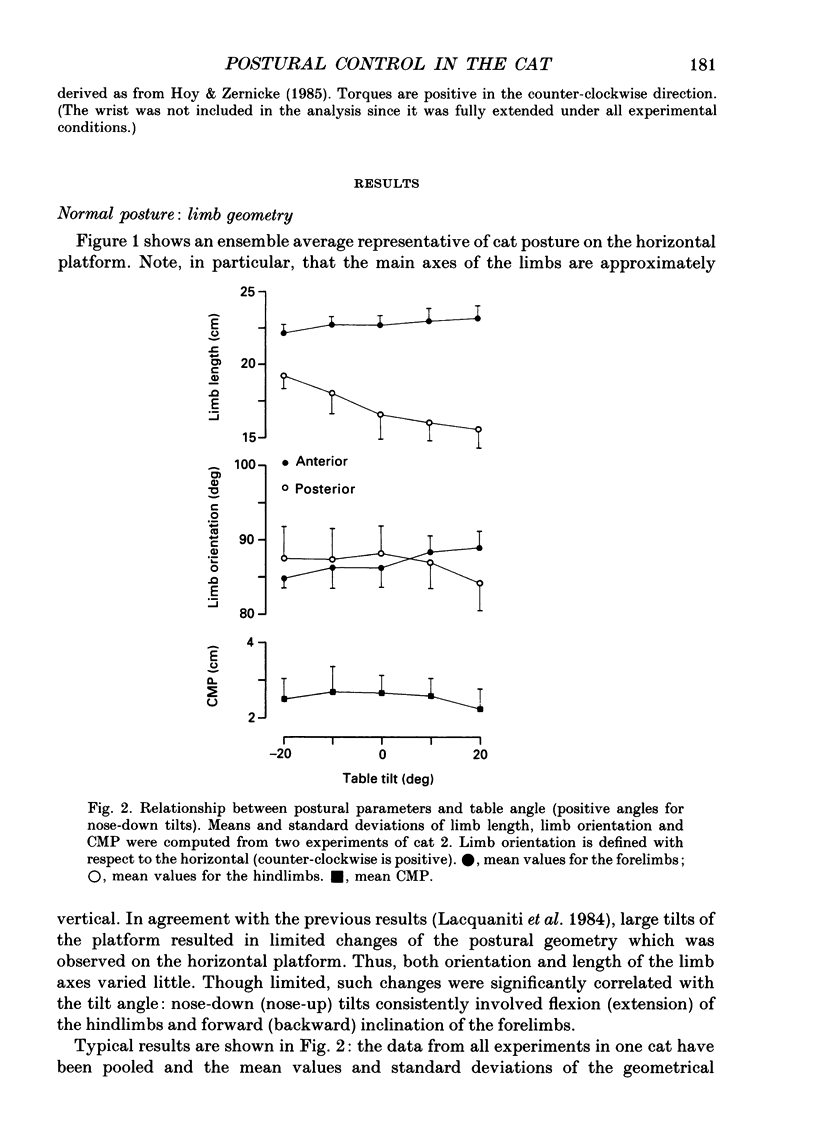
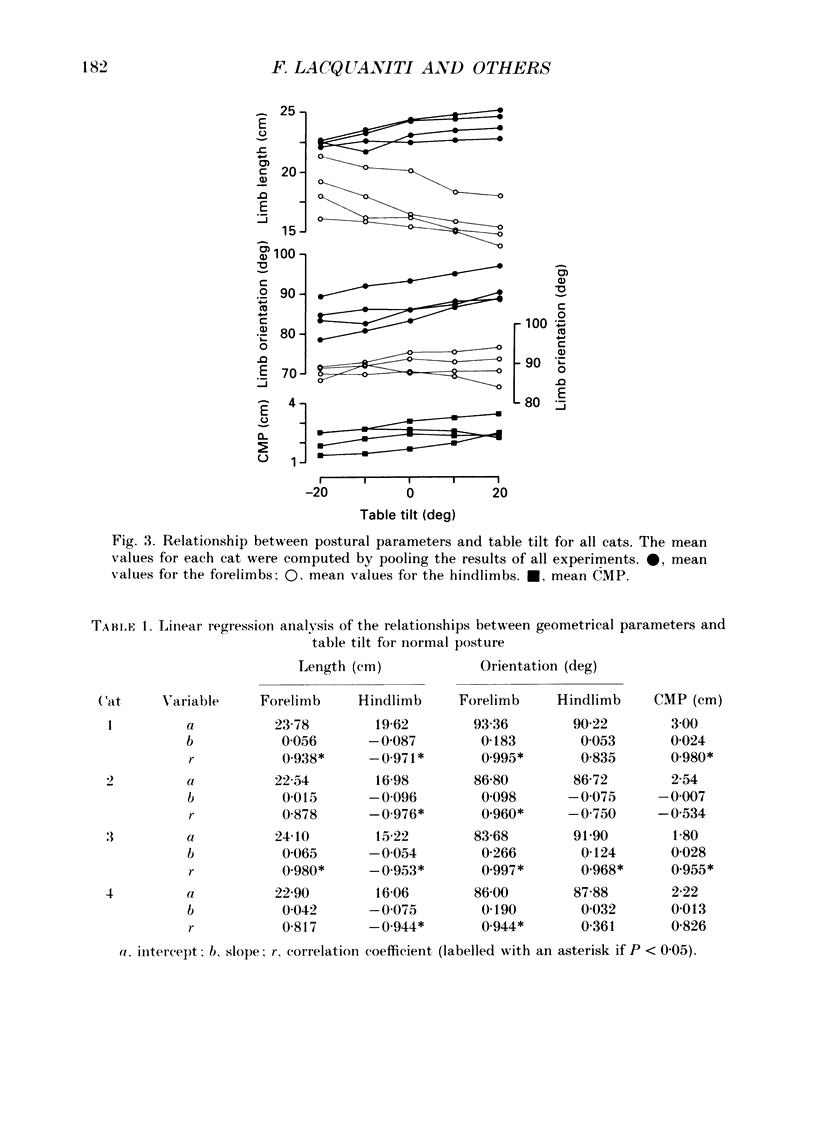
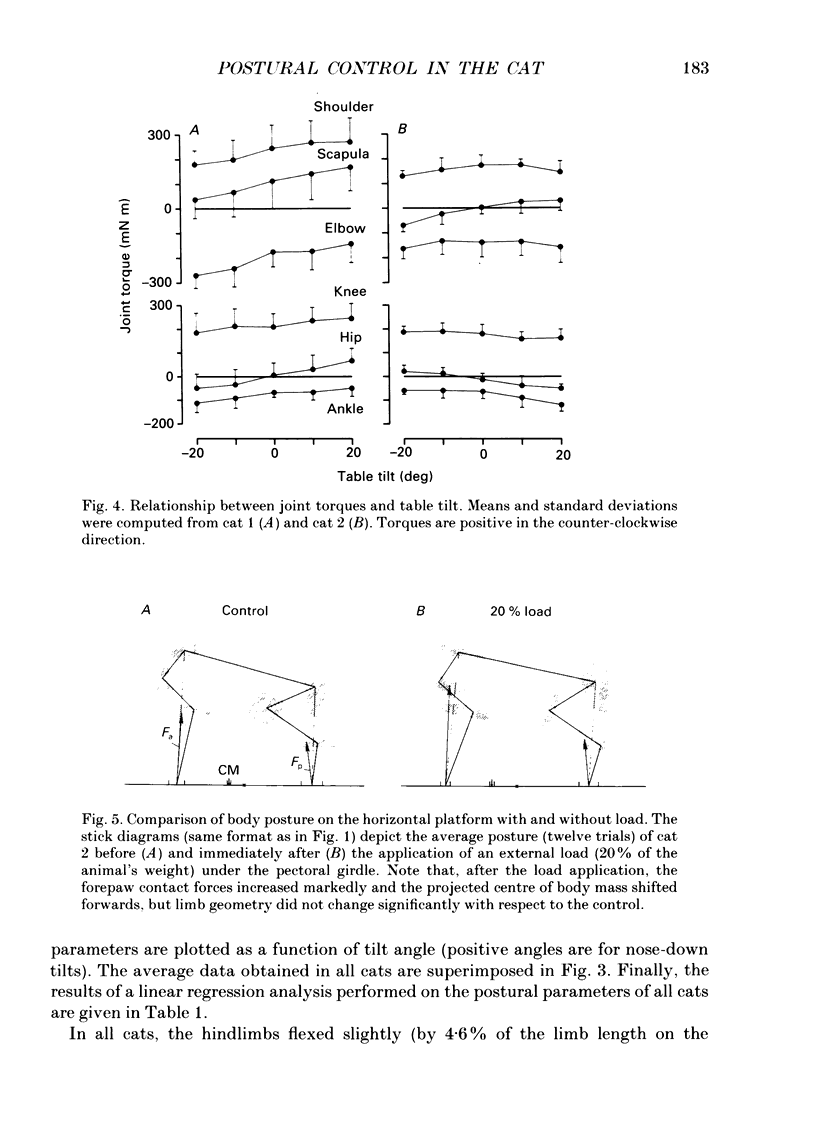
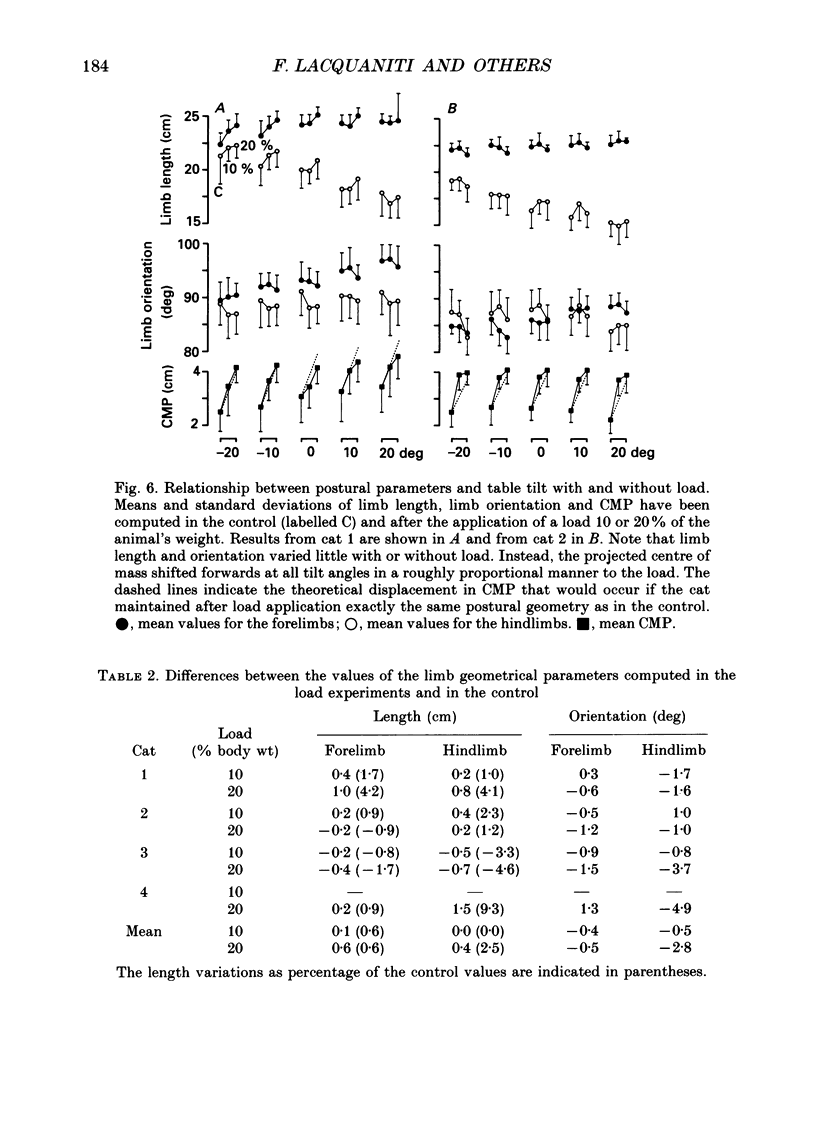
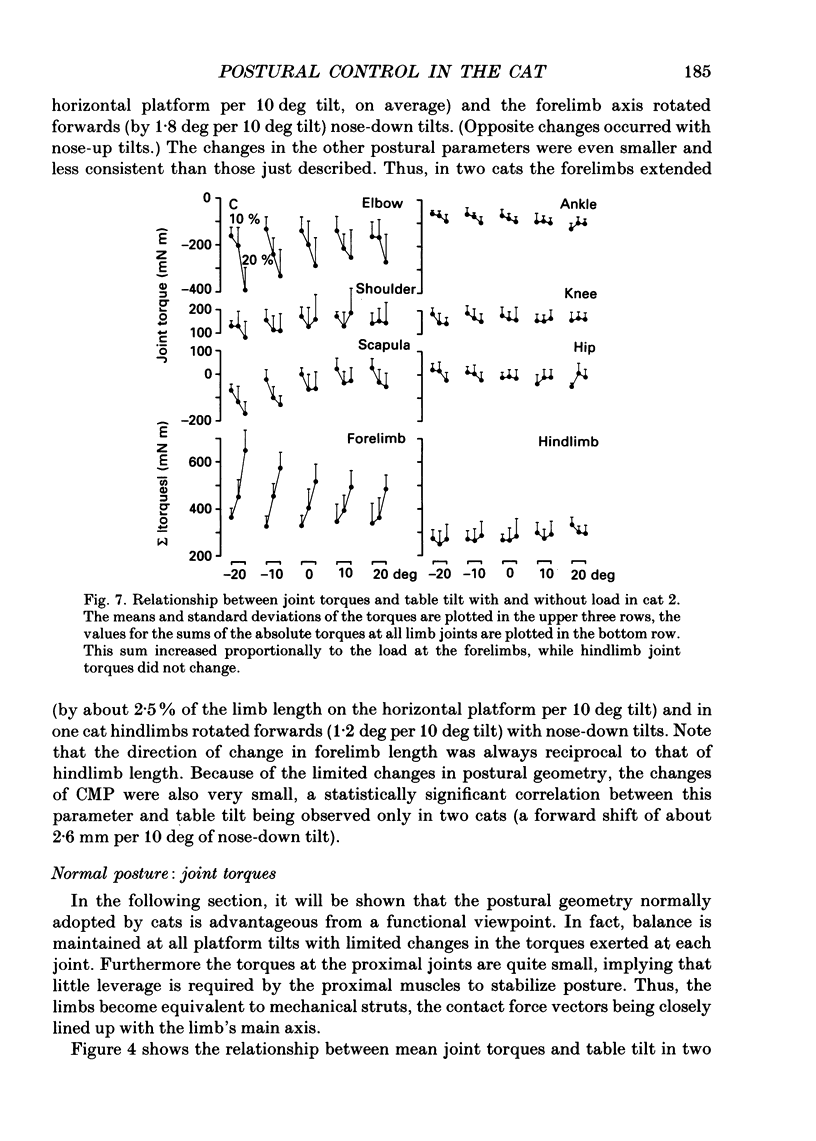
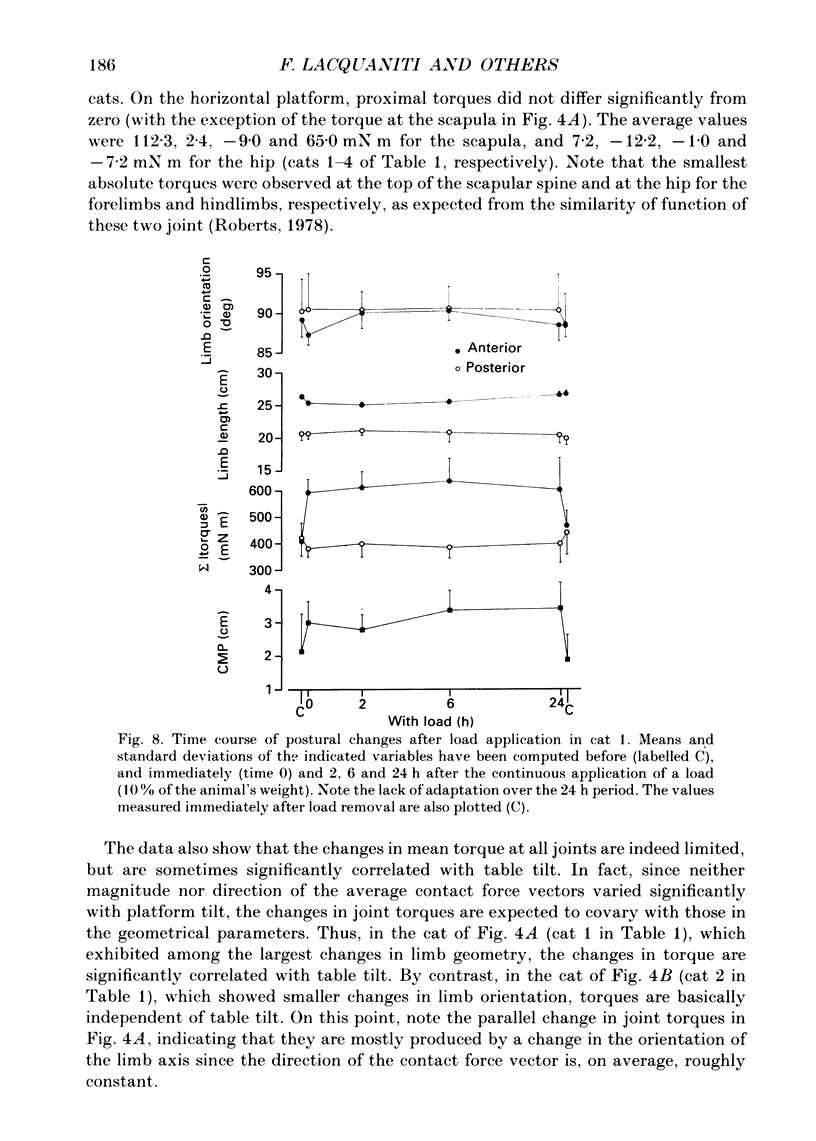
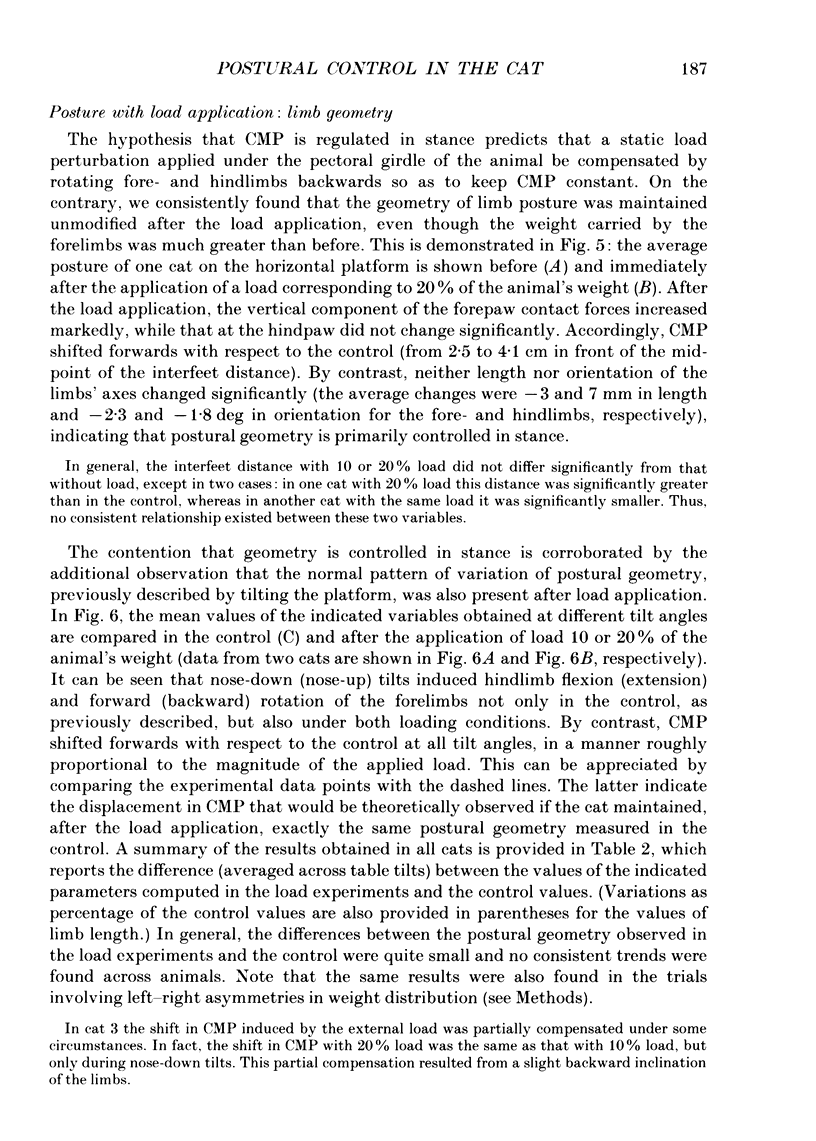
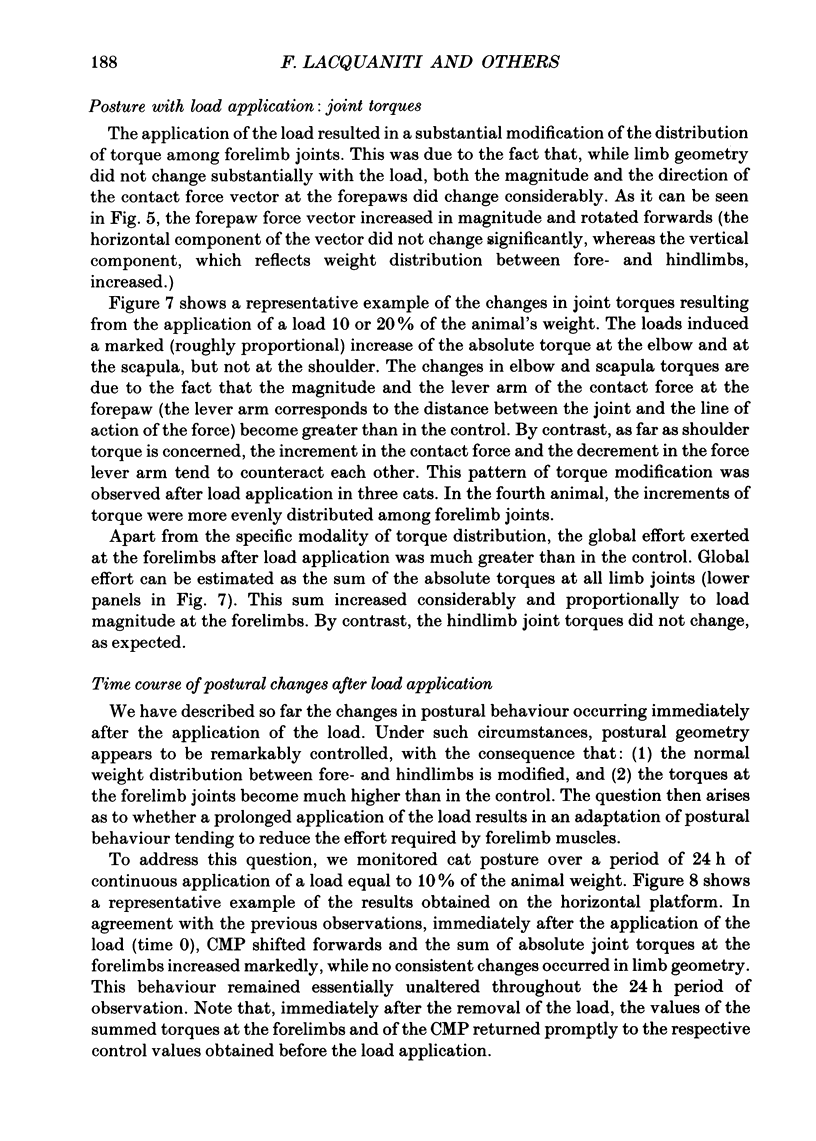
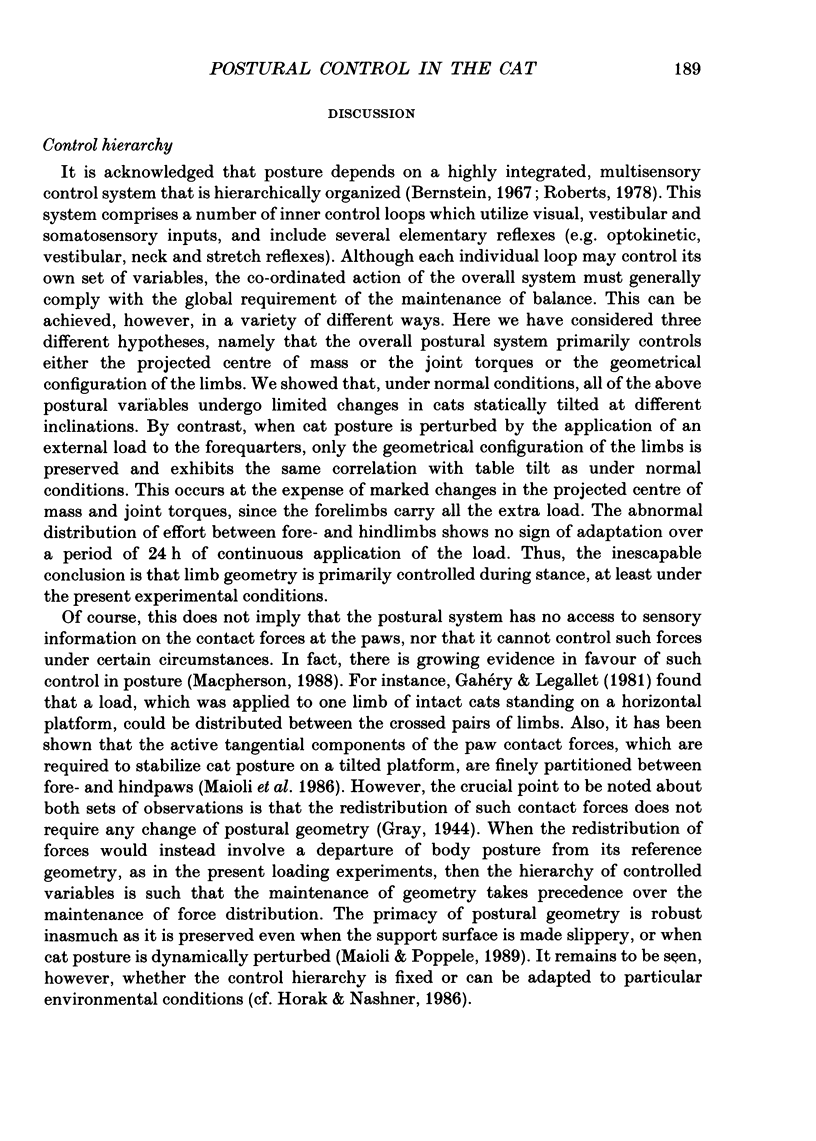
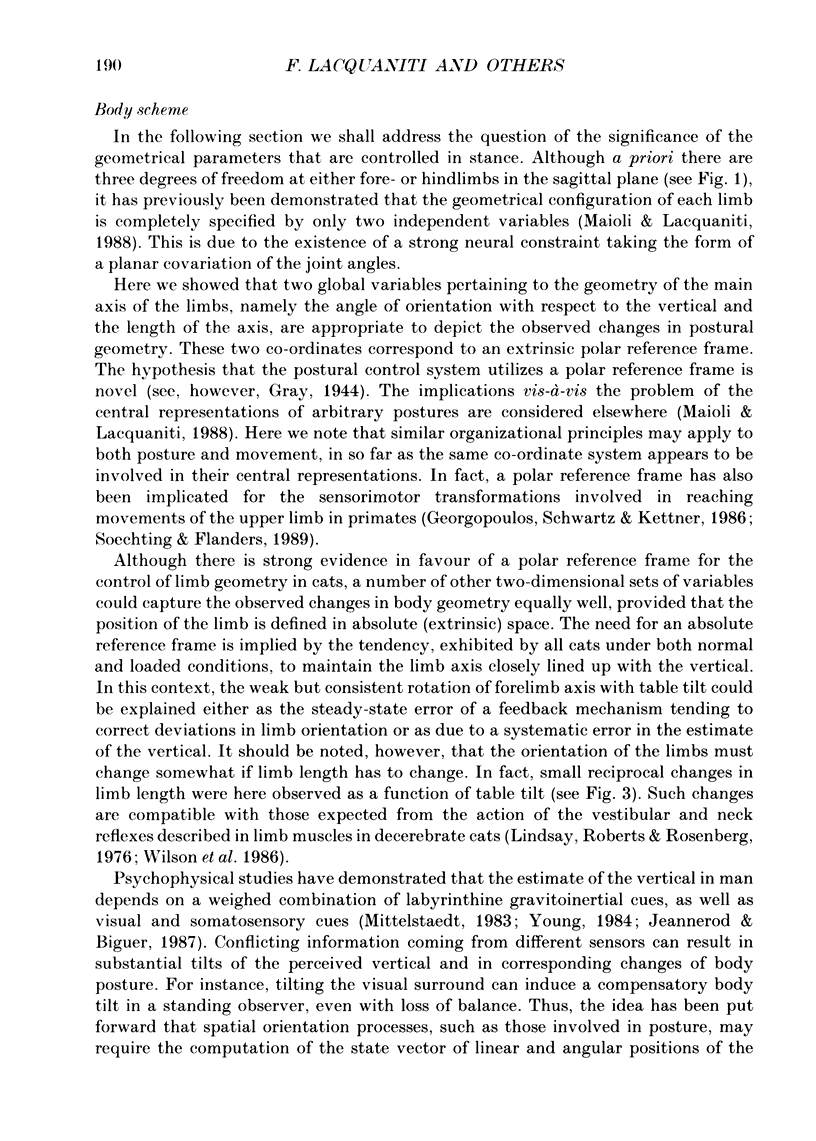

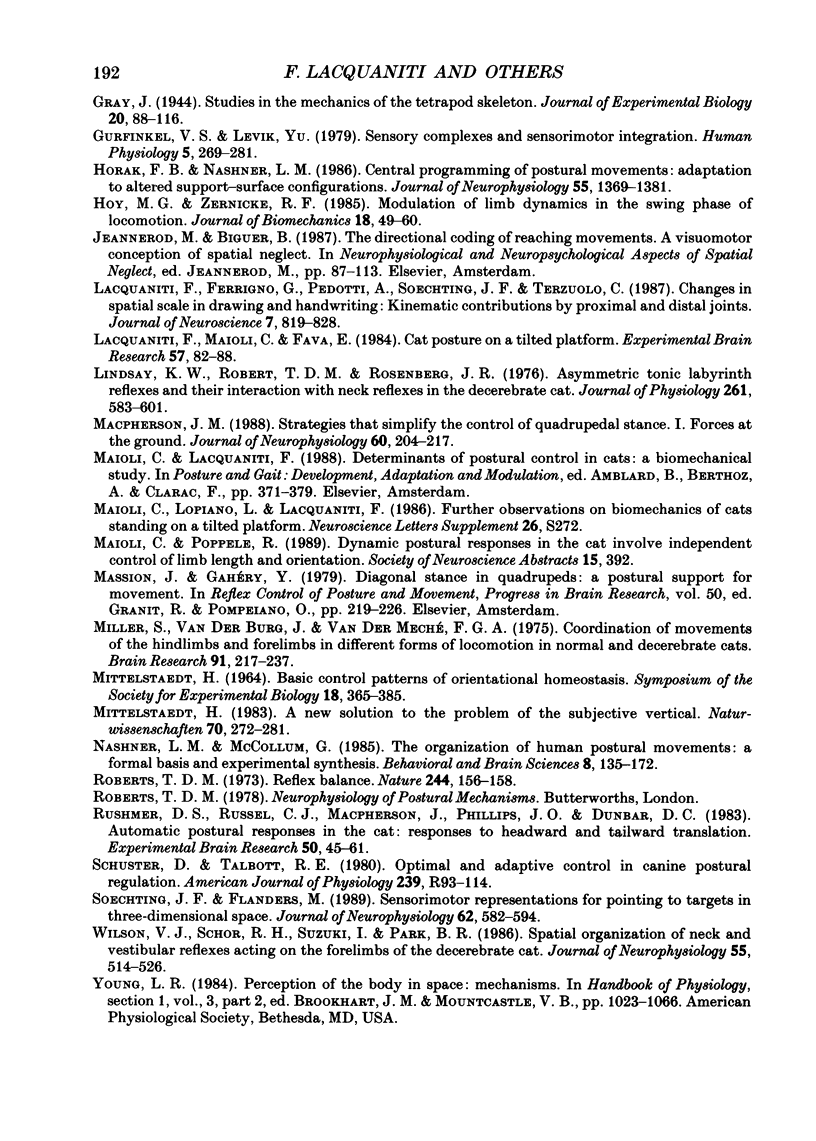
Selected References
These references are in PubMed. This may not be the complete list of references from this article.
- BROOKHART J. M., PARMEGGIANI P. L., PETERSEN W. A., STONE S. A. POSTURAL STABILITY IN THE DOG. Am J Physiol. 1965 Jun;208:1047–1057. doi: 10.1152/ajplegacy.1965.208.6.1047. [DOI] [PubMed] [Google Scholar]
- Brookhart J. M., Talbott R. E. The postural response of normal dogs to sinusoidal displacement. J Physiol. 1974 Dec;243(2):287–307. doi: 10.1113/jphysiol.1974.sp010754. [DOI] [PMC free article] [PubMed] [Google Scholar]
- Clément G., Gurfinkel V. S., Lestienne F., Lipshits M. I., Popov K. E. Adaptation of postural control to weightlessness. Exp Brain Res. 1984;57(1):61–72. doi: 10.1007/BF00231132. [DOI] [PubMed] [Google Scholar]
- Coulmance M., Gahéry Y., Massion J., Swett J. E. The placing reaction in the standing cat: a model for the study of posture and movement. Exp Brain Res. 1979 Oct;37(2):265–281. doi: 10.1007/BF00237713. [DOI] [PubMed] [Google Scholar]
- Crenna P., Frigo C., Massion J., Pedotti A. Forward and backward axial synergies in man. Exp Brain Res. 1987;65(3):538–548. doi: 10.1007/BF00235977. [DOI] [PubMed] [Google Scholar]
- Ferrigno G., Pedotti A. ELITE: a digital dedicated hardware system for movement analysis via real-time TV signal processing. IEEE Trans Biomed Eng. 1985 Nov;32(11):943–950. doi: 10.1109/TBME.1985.325627. [DOI] [PubMed] [Google Scholar]
- Gahéry Y., Legallet E. Influence of initial posture on posturo-kinetic co-ordination in the cat. Exp Brain Res. 1981;44(2):177–186. doi: 10.1007/BF00237339. [DOI] [PubMed] [Google Scholar]
- Georgopoulos A. P., Schwartz A. B., Kettner R. E. Neuronal population coding of movement direction. Science. 1986 Sep 26;233(4771):1416–1419. doi: 10.1126/science.3749885. [DOI] [PubMed] [Google Scholar]
- Gurfinkel' V. S., Levik YuS Sensory complexes and sensomotor integration. Hum Physiol. 1979 May-Jun;5(3):269–281. [PubMed] [Google Scholar]
- Horak F. B., Nashner L. M. Central programming of postural movements: adaptation to altered support-surface configurations. J Neurophysiol. 1986 Jun;55(6):1369–1381. doi: 10.1152/jn.1986.55.6.1369. [DOI] [PubMed] [Google Scholar]
- Hoy M. G., Zernicke R. F. Modulation of limb dynamics in the swing phase of locomotion. J Biomech. 1985;18(1):49–60. doi: 10.1016/0021-9290(85)90044-2. [DOI] [PubMed] [Google Scholar]
- Lacquaniti F., Ferrigno G., Pedotti A., Soechting J. F., Terzuolo C. Changes in spatial scale in drawing and handwriting: kinematic contributions by proximal and distal joints. J Neurosci. 1987 Mar;7(3):819–828. doi: 10.1523/JNEUROSCI.07-03-00819.1987. [DOI] [PMC free article] [PubMed] [Google Scholar]
- Lacquaniti F., Maioli C., Fava E. Cat posture on a tilted platform. Exp Brain Res. 1984;57(1):82–88. doi: 10.1007/BF00231134. [DOI] [PubMed] [Google Scholar]
- Lindsay K. W., Roberts T. D., Rosenberg J. R. Asymmetric tonic labyrinth reflexes and their interaction with neck reflexes in the decerebrate cat. J Physiol. 1976 Oct;261(3):583–601. doi: 10.1113/jphysiol.1976.sp011575. [DOI] [PMC free article] [PubMed] [Google Scholar]
- Macpherson J. M. Strategies that simplify the control of quadrupedal stance. I. Forces at the ground. J Neurophysiol. 1988 Jul;60(1):204–217. doi: 10.1152/jn.1988.60.1.204. [DOI] [PubMed] [Google Scholar]
- Massion J., Gahery Y. Diagonal stance in quadrupeds: a postural support for movement. Prog Brain Res. 1979;50:219–226. doi: 10.1016/S0079-6123(08)60822-5. [DOI] [PubMed] [Google Scholar]
- Miller S., Van Der Burg J., Van Der Meché F. Coordination of movements of the kindlimbs and forelimbs in different forms of locomotion in normal and decerebrate cats. Brain Res. 1975 Jun 27;91(2):217–237. doi: 10.1016/0006-8993(75)90544-2. [DOI] [PubMed] [Google Scholar]
- Mittelstaedt H. A new solution to the problem of the subjective vertical. Naturwissenschaften. 1983 Jun;70(6):272–281. doi: 10.1007/BF00404833. [DOI] [PubMed] [Google Scholar]
- Mittelstaedt H. Basic control patterns of orientational homeostasis. Symp Soc Exp Biol. 1964;18:365–385. [PubMed] [Google Scholar]
- Roberts T. D. Reflex balance. Nature. 1973 Jul 20;244(5412):156–158. doi: 10.1038/244156a0. [DOI] [PubMed] [Google Scholar]
- Rushmer D. S., Russell C. J., macpherson J., Phillips J. O., Dunbar D. C. Automatic postural responses in the cat: responses to headward and tailward translation. Exp Brain Res. 1983;50(1):45–61. doi: 10.1007/BF00238231. [DOI] [PubMed] [Google Scholar]
- Schuster D., Talbott R. E. Optimal and adaptive control in canine postural regulation. Am J Physiol. 1980 Jul;239(1):R93–114. doi: 10.1152/ajpregu.1980.239.1.R93. [DOI] [PubMed] [Google Scholar]
- Soechting J. F., Flanders M. Sensorimotor representations for pointing to targets in three-dimensional space. J Neurophysiol. 1989 Aug;62(2):582–594. doi: 10.1152/jn.1989.62.2.582. [DOI] [PubMed] [Google Scholar]
- Wilson V. J., Schor R. H., Suzuki I., Park B. R. Spatial organization of neck and vestibular reflexes acting on the forelimbs of the decerebrate cat. J Neurophysiol. 1986 Mar;55(3):514–526. doi: 10.1152/jn.1986.55.3.514. [DOI] [PubMed] [Google Scholar]


